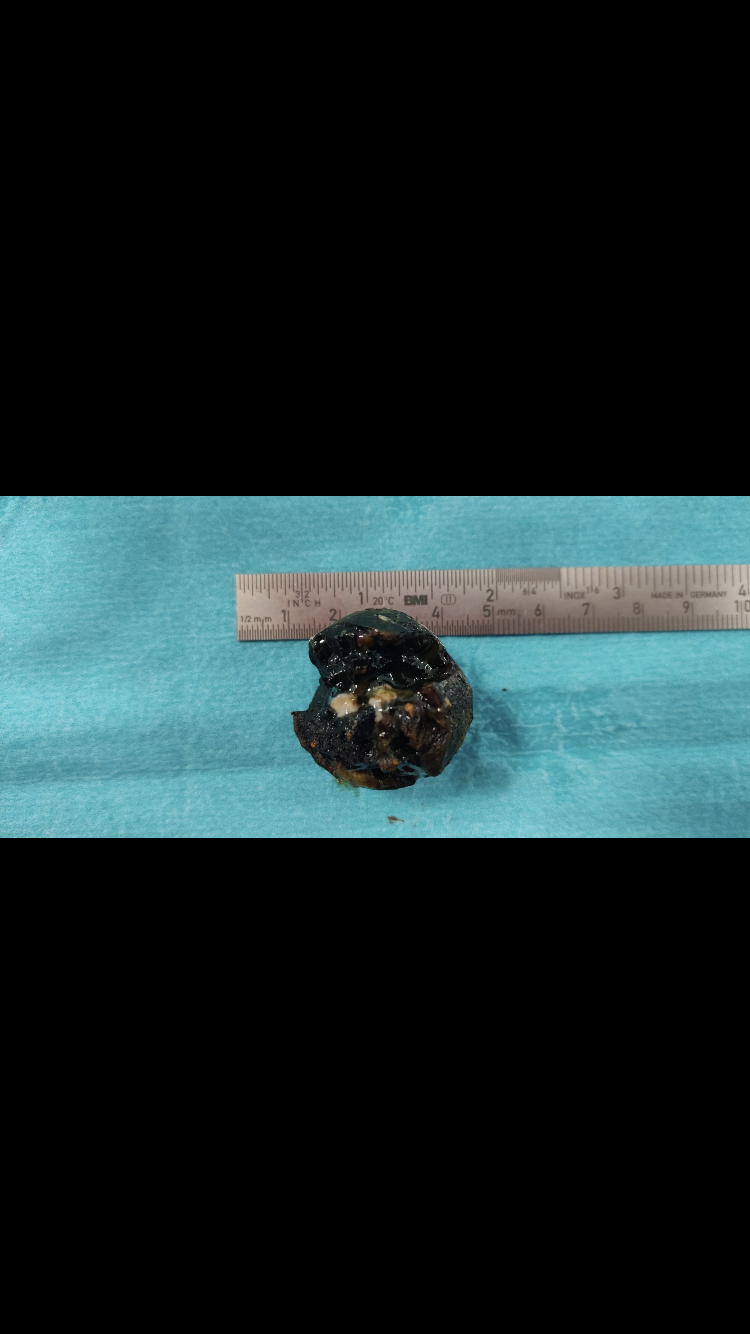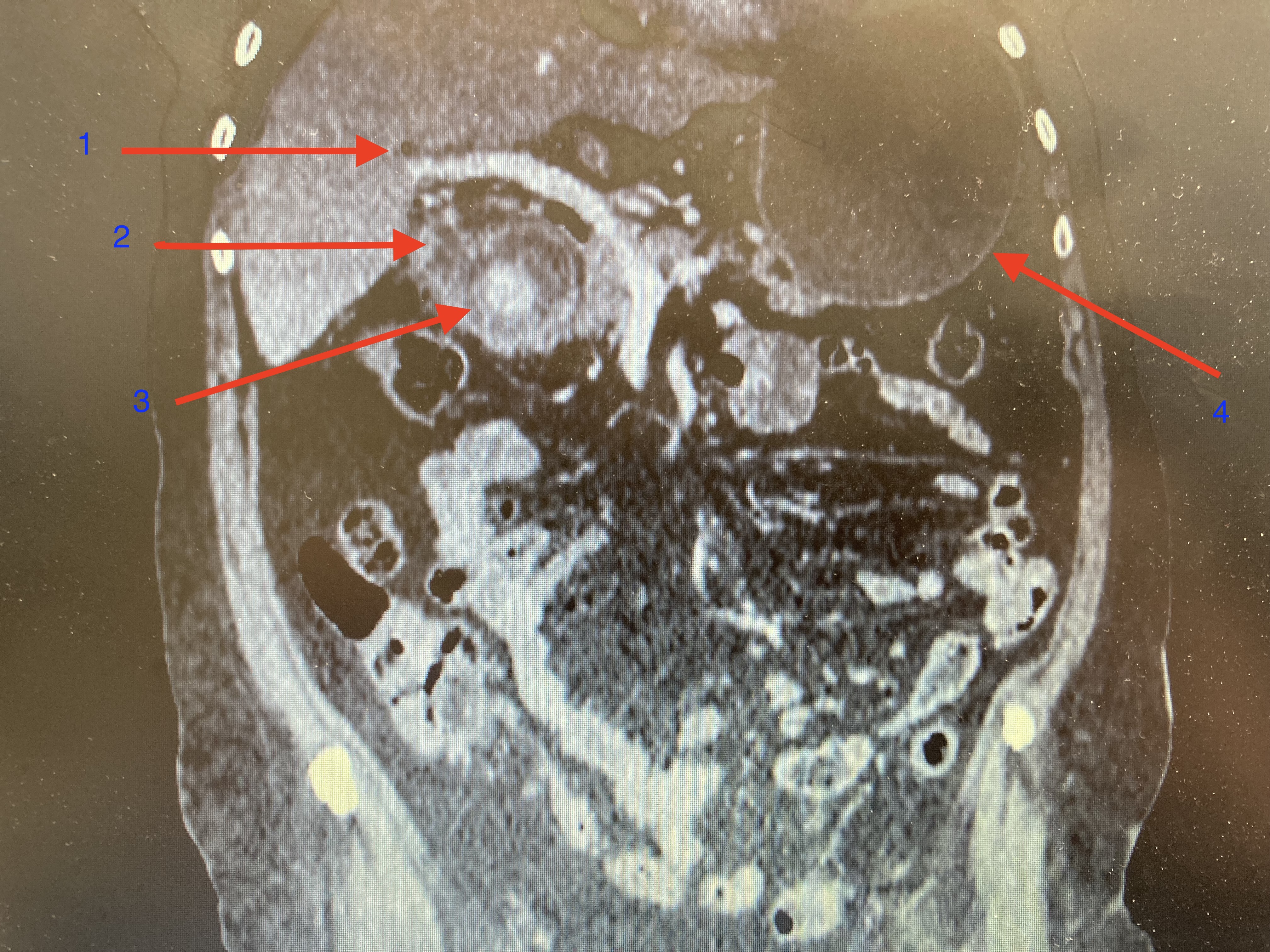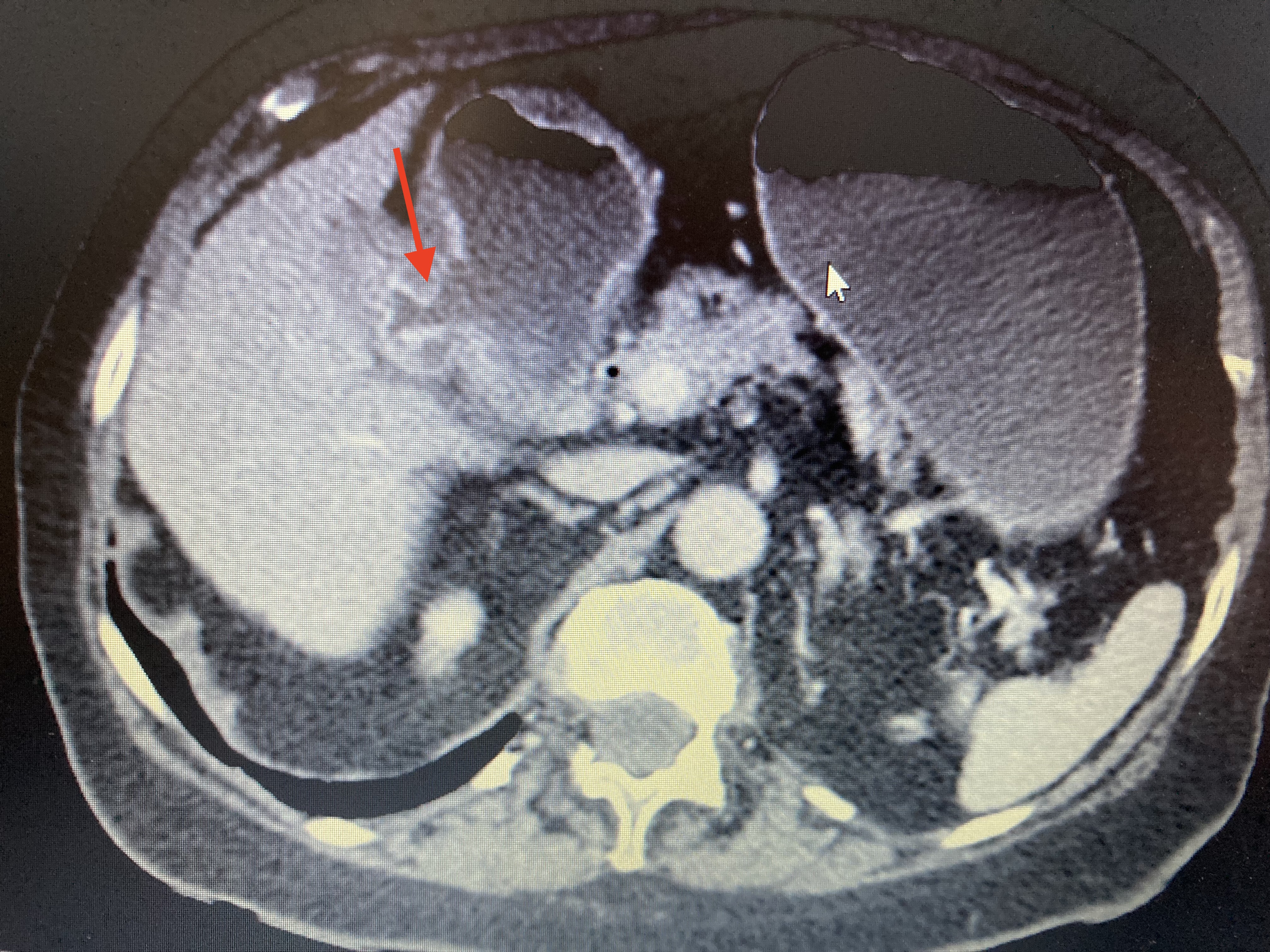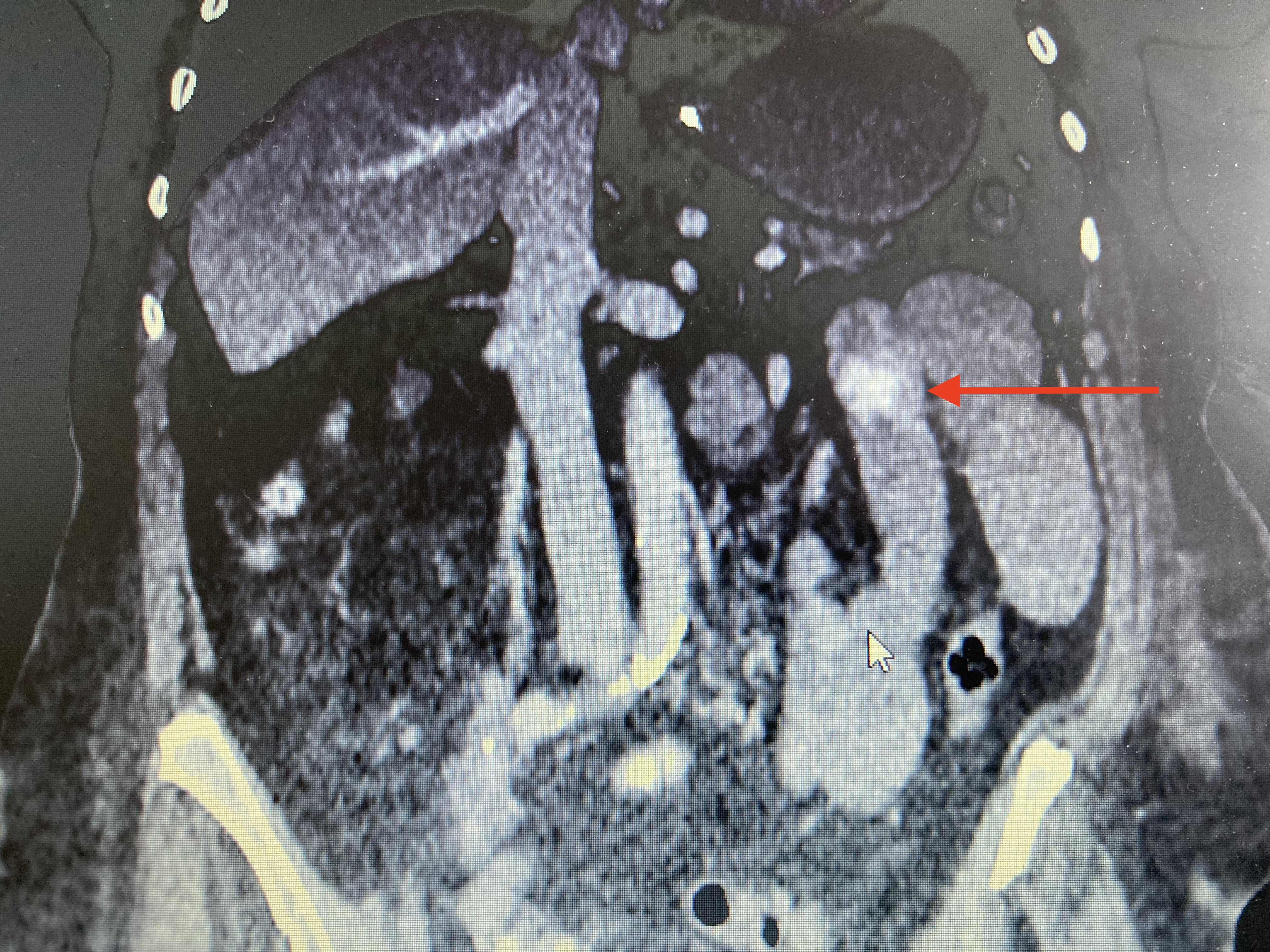[1]
Abou-Saif A, Al-Kawas FH. Complications of gallstone disease: Mirizzi syndrome, cholecystocholedochal fistula, and gallstone ileus. The American journal of gastroenterology. 2002 Feb:97(2):249-54
[PubMed PMID: 11866258]
[2]
Jin L, Naidu K. Bouveret syndrome-a rare form of gastric outlet obstruction. Journal of surgical case reports. 2021 May:2021(5):rjab183. doi: 10.1093/jscr/rjab183. Epub 2021 May 19
[PubMed PMID: 34040753]
Level 3 (low-level) evidence
[3]
Lawther RE, Diamond T. Bouveret's syndrome: gallstone ileus causing gastric outlet obstruction. The Ulster medical journal. 2000 May:69(1):69-70
[PubMed PMID: 10881651]
[4]
Haddad FG, Mansour W, Deeb L. Bouveret's Syndrome: Literature Review. Cureus. 2018 Mar 10:10(3):e2299. doi: 10.7759/cureus.2299. Epub 2018 Mar 10
[PubMed PMID: 29755896]
[5]
Yılmaz EM, Cartı EB, Kandemir A. Rare cause of duodenal obstruction: Bouveret syndrome. Turkish journal of surgery. 2018 Aug 28:():1-3. doi: 10.5152/turkjsurg.2017.3794. Epub 2018 Aug 28
[PubMed PMID: 30216175]
[6]
Rodrigues ILM. Bouveret syndrome and its imaging diagnosis. Radiologia brasileira. 2018 Jul-Aug:51(4):276-277. doi: 10.1590/0100-3984.2016.0220. Epub
[PubMed PMID: 30202139]
[7]
Haddad FG, Mansour W, Mansour J, Deeb L. From Bouveret's Syndrome to Gallstone Ileus: The Journey of a Migrating Stone! Cureus. 2018 Mar 26:10(3):e2370. doi: 10.7759/cureus.2370. Epub 2018 Mar 26
[PubMed PMID: 29805939]
[8]
Baharith H, Khan K. Bouveret syndrome: when there are no options. Canadian journal of gastroenterology & hepatology. 2015 Jan-Feb:29(1):17-8
[PubMed PMID: 25706571]
[9]
Ayantunde AA, Agrawal A. Gallstone ileus: diagnosis and management. World journal of surgery. 2007 Jun:31(6):1292-7
[PubMed PMID: 17436117]
[10]
Warren DJ, Peck RJ, Majeed AW. Bouveret's Syndrome: a Case Report. Journal of radiology case reports. 2008:2(4):14-7. doi: 10.3941/jrcr.v2i4.60. Epub 2008 Oct 1
[PubMed PMID: 22470599]
Level 3 (low-level) evidence
[11]
Langhorst J, Schumacher B, Deselaers T, Neuhaus H. Successful endoscopic therapy of a gastric outlet obstruction due to a gallstone with intracorporeal laser lithotripsy: a case of Bouveret's syndrome. Gastrointestinal endoscopy. 2000 Feb:51(2):209-13
[PubMed PMID: 10650271]
Level 3 (low-level) evidence
[12]
Zissin R, Osadchy A, Klein E, Konikoff F. Consecutive instances of gallstone ileus due to obstruction first at the ileum and then at the duodenum complicating a gallbladder carcinoma: a case report. Emergency radiology. 2006 Mar:12(3):108-10
[PubMed PMID: 16362271]
Level 3 (low-level) evidence
[13]
Shinoda M, Aiura K, Yamagishi Y, Masugi Y, Takano K, Maruyama S, Irino T, Takabayashi K, Hoshino Y, Nishiya S, Hibi T, Kawachi S, Tanabe M, Ueda M, Sakamoto M, Hibi T, Kitagawa Y. Bouveret's syndrome with a concomitant incidental T1 gallbladder cancer. Clinical journal of gastroenterology. 2010 Oct:3(5):248-53. doi: 10.1007/s12328-010-0170-0. Epub 2010 Sep 4
[PubMed PMID: 26190330]
[14]
Sharma D, Jakhetia A, Agarwal L, Baruah D, Rohtagi A, Kumar A. Carcinoma Gall Bladder with Bouveret's Syndrome: A Rare Cause of Gastric Outlet Obstruction. The Indian journal of surgery. 2010 Aug:72(4):350-1. doi: 10.1007/s12262-010-0145-x. Epub 2010 Nov 23
[PubMed PMID: 21938203]
[15]
Mavroeidis VK, Matthioudakis DI, Economou NK, Karanikas ID. Bouveret syndrome-the rarest variant of gallstone ileus: a case report and literature review. Case reports in surgery. 2013:2013():839370. doi: 10.1155/2013/839370. Epub 2013 Jun 24
[PubMed PMID: 23864977]
Level 3 (low-level) evidence
[16]
Osman K, Maselli D, Kendi AT, Larson M. Bouveret's syndrome and cholecystogastric fistula: a case-report and review of the literature. Clinical journal of gastroenterology. 2020 Aug:13(4):527-531. doi: 10.1007/s12328-020-01114-7. Epub 2020 Mar 30
[PubMed PMID: 32232771]
Level 3 (low-level) evidence
[17]
Iancu C, Bodea R, Al Hajjar N, Todea-Iancu D, Bălă O, Acalovschi I. Bouveret syndrome associated with acute gangrenous cholecystitis. Journal of gastrointestinal and liver diseases : JGLD. 2008 Mar:17(1):87-90
[PubMed PMID: 18392252]
[18]
Cappell MS, Davis M. Characterization of Bouveret's syndrome: a comprehensive review of 128 cases. The American journal of gastroenterology. 2006 Sep:101(9):2139-46
[PubMed PMID: 16817848]
Level 3 (low-level) evidence
[19]
Alibegovic E, Kurtcehajic A, Hujdurovic A, Mujagic S, Alibegovic J, Kurtcehajic D. Bouveret Syndrome or Gallstone Ileus. The American journal of medicine. 2018 Apr:131(4):e175. doi: 10.1016/j.amjmed.2017.10.044. Epub
[PubMed PMID: 29555049]
[20]
Su HL, Tsai MJ. Bouveret syndrome. QJM : monthly journal of the Association of Physicians. 2018 Jul 1:111(7):489-490. doi: 10.1093/qjmed/hcy020. Epub
[PubMed PMID: 29394400]
[21]
Di Re AM, Punch G, Richardson AJ, Pleass H. Rare case of Bouveret syndrome. ANZ journal of surgery. 2019 May:89(5):E198-E199. doi: 10.1111/ans.14215. Epub 2017 Oct 13
[PubMed PMID: 29027328]
Level 3 (low-level) evidence
[22]
Yu YB, Song Y, Xu JB, Qi FZ. Bouveret's syndrome: A rare presentation of gastric outlet obstruction. Experimental and therapeutic medicine. 2019 Mar:17(3):1813-1816. doi: 10.3892/etm.2019.7150. Epub 2019 Jan 3
[PubMed PMID: 30783453]
Level 2 (mid-level) evidence
[23]
Dumonceau JM, Devière J. Novel treatment options for Bouveret's syndrome: a comprehensive review of 61 cases of successful endoscopic treatment. Expert review of gastroenterology & hepatology. 2016 Nov:10(11):1245-1255
[PubMed PMID: 27677937]
Level 3 (low-level) evidence
[24]
Iñíguez A, Butte JM, Zúñiga JM, Crovari F, Llanos O. [Bouveret syndrome: report of four cases]. Revista medica de Chile. 2008 Feb:136(2):163-8
[PubMed PMID: 18483669]
Level 3 (low-level) evidence
[25]
Ong J, Swift C, Stokell BG, Ong S, Lucarelli P, Shankar A, Rouhani FJ, Al-Naeeb Y. Bouveret Syndrome: A Systematic Review of Endoscopic Therapy and a Novel Predictive Tool to Aid in Management. Journal of clinical gastroenterology. 2020 Oct:54(9):758-768. doi: 10.1097/MCG.0000000000001221. Epub
[PubMed PMID: 32898384]
Level 1 (high-level) evidence
[26]
Lowe AS, Stephenson S, Kay CL, May J. Duodenal obstruction by gallstones (Bouveret's syndrome): a review of the literature. Endoscopy. 2005 Jan:37(1):82-7
[PubMed PMID: 15657864]
[27]
Jindal A, Philips CA, Jamwal K, Sarin SK. Use of a Roth Net Platinum Universal Retriever for the endoscopic management of a large symptomatic gallstone causing Bouveret's syndrome. Endoscopy. 2016 Sep:48(S 01):E308
[PubMed PMID: 27669536]
[28]
Kaushik N, Moser AJ, Slivka A, Chandrupatala S, Martin JA. Gastric outlet obstruction caused by gallstones: case report and review of the literature. Digestive diseases and sciences. 2005 Mar:50(3):470-3
[PubMed PMID: 15810628]
Level 3 (low-level) evidence
[29]
Binmoeller KF, Brückner M, Thonke F, Soehendra N. Treatment of difficult bile duct stones using mechanical, electrohydraulic and extracorporeal shock wave lithotripsy. Endoscopy. 1993 Mar:25(3):201-6
[PubMed PMID: 8519238]
[30]
Kozarek RA, Low DE, Ball TJ. Tunable dye laser lithotripsy: in vitro studies and in vivo treatment of choledocholithiasis. Gastrointestinal endoscopy. 1988 Sep-Oct:34(5):418-21
[PubMed PMID: 2903114]
[31]
Cotton PB, Kozarek RA, Schapiro RH, Nishioka NS, Kelsey PB, Ball TJ, Putnam WS, Barkun A, Weinerth J. Endoscopic laser lithotripsy of large bile duct stones. Gastroenterology. 1990 Oct:99(4):1128-33
[PubMed PMID: 1975549]
[32]
Lv S, Fang Z, Wang A, Yang J, Zhang W. Choledochoscopic Holmium Laser Lithotripsy for Difficult Bile Duct Stones. Journal of laparoendoscopic & advanced surgical techniques. Part A. 2017 Jan:27(1):24-27. doi: 10.1089/lap.2016.0289. Epub 2017 Jan 3
[PubMed PMID: 28048950]
[33]
Schatloff O, Rimon U, Garniek A, Lindner U, Morag R, Mor Y, Ramon J, Winkler H. Percutaneous transhepatic lithotripsy with the holmium: YAG laser for the treatment of refractory biliary lithiasis. Surgical laparoscopy, endoscopy & percutaneous techniques. 2009 Apr:19(2):106-9. doi: 10.1097/SLE.0b013e31819fa5d5. Epub
[PubMed PMID: 19390274]
[34]
Alsolaiman MM, Reitz C, Nawras AT, Rodgers JB, Maliakkal BJ. Bouveret's syndrome complicated by distal gallstone ileus after laser lithotropsy using Holmium: YAG laser. BMC gastroenterology. 2002 Jun 18:2():15
[PubMed PMID: 12086587]
[35]
Pickhardt PJ, Friedland JA, Hruza DS, Fisher AJ. Case report. CT, MR cholangiopancreatography, and endoscopy findings in Bouveret's syndrome. AJR. American journal of roentgenology. 2003 Apr:180(4):1033-5
[PubMed PMID: 12646450]
Level 3 (low-level) evidence
[36]
Rogart JN, Perkal M, Nagar A. Successful Multimodality Endoscopic Treatment of Gastric Outlet Obstruction Caused by an Impacted Gallstone (Bouveret's Syndrome). Diagnostic and therapeutic endoscopy. 2008:2008():471512. doi: 10.1155/2008/471512. Epub
[PubMed PMID: 18493330]
[37]
ASGE Technology Committee, Watson RR, Parsi MA, Aslanian HR, Goodman AJ, Lichtenstein DR, Melson J, Navaneethan U, Pannala R, Sethi A, Sullivan SA, Thosani NC, Trikudanathan G, Trindade AJ, Maple JT. Biliary and pancreatic lithotripsy devices. VideoGIE : an official video journal of the American Society for Gastrointestinal Endoscopy. 2018 Nov:3(11):329-338. doi: 10.1016/j.vgie.2018.07.010. Epub 2018 Sep 26
[PubMed PMID: 30402576]
[38]
Reinhardt SW, Jin LX, Pitt SC, Earl TM, Chapman WC, Doyle MB. Bouveret's syndrome complicated by classic gallstone ileus: progression of disease or iatrogenic? Journal of gastrointestinal surgery : official journal of the Society for Surgery of the Alimentary Tract. 2013 Nov:17(11):2020-4. doi: 10.1007/s11605-013-2301-7. Epub 2013 Sep 10
[PubMed PMID: 24018589]
[39]
Pavlidis TE, Atmatzidis KS, Papaziogas BT, Papaziogas TB. Management of gallstone ileus. Journal of hepato-biliary-pancreatic surgery. 2003:10(4):299-302
[PubMed PMID: 14598150]
[40]
Gallego Otaegui L, Sainz Lete A, Gutiérrez Ríos RD, Alkorta Zuloaga M, Arteaga Martín X, Jiménez Agüero R, Medrano Gómez MÁ, Ruiz Montesinos I, Beguiristain Gómez A. A rare presentation of gallstones: Bouveret´s syndrome, a case report. Revista espanola de enfermedades digestivas. 2016 Jul:108(7):434-6
[PubMed PMID: 27659106]
Level 3 (low-level) evidence
[41]
Stein PH, Lee C, Sejpal DV. A Rock and a Hard Place: Successful Combined Endoscopic and Surgical Treatment of Bouveret's Syndrome. Clinical gastroenterology and hepatology : the official clinical practice journal of the American Gastroenterological Association. 2015 Dec:13(13):A25-6. doi: 10.1016/j.cgh.2015.07.044. Epub 2015 Aug 5
[PubMed PMID: 26254202]
[42]
Thompson RJ, Gidwani A, Caddy G, McKenna E, McCallion K. Endoscopically assisted minimally invasive surgery for gallstones. Irish journal of medical science. 2009 Mar:178(1):85-7
[PubMed PMID: 17973154]
[43]
Newton RC, Loizides S, Penney N, Singh KK. Laparoscopic management of Bouveret syndrome. BMJ case reports. 2015 Apr 22:2015():. doi: 10.1136/bcr-2015-209869. Epub 2015 Apr 22
[PubMed PMID: 25903213]
Level 3 (low-level) evidence
[44]
Yang D, Wang Z, Duan ZJ, Jin S. Laparoscopic treatment of an upper gastrointestinal obstruction due to Bouveret's syndrome. World journal of gastroenterology. 2013 Oct 28:19(40):6943-6. doi: 10.3748/wjg.v19.i40.6943. Epub
[PubMed PMID: 24187475]
[45]
Balakrishnan S, Samdani T, Singhal T, Hussain A, Grandy-Smith S, Nicholls J, El-Hasani S. Patient experience with gallstone disease in a national health service district hospital. JSLS : Journal of the Society of Laparoendoscopic Surgeons. 2008 Oct-Dec:12(4):389-94
[PubMed PMID: 19275855]
[46]
Hussain A. Difficult laparoscopic cholecystectomy: current evidence and strategies of management. Surgical laparoscopy, endoscopy & percutaneous techniques. 2011 Aug:21(4):211-7. doi: 10.1097/SLE.0b013e318220f1b1. Epub
[PubMed PMID: 21857467]
[47]
Jafferbhoy S, Rustum Q, Shiwani M. Bouveret's syndrome: should we remove the gall bladder? BMJ case reports. 2011 Apr 1:2011():. doi: 10.1136/bcr.02.2011.3891. Epub 2011 Apr 1
[PubMed PMID: 22700609]
Level 3 (low-level) evidence
[48]
Lee W, Han SS, Lee SD, Kim YK, Kim SH, Woo SM, Lee WJ, Koh YW, Hong EK, Park SJ. Bouveret's syndrome: a case report and a review of the literature. Korean journal of hepato-biliary-pancreatic surgery. 2012 May:16(2):84-7. doi: 10.14701/kjhbps.2012.16.2.84. Epub 2012 May 31
[PubMed PMID: 26388913]
Level 3 (low-level) evidence
[49]
Lopes CV, Lima FK, Hartmann AA. Bouveret syndrome and pancreatic acinar cell carcinoma. Endoscopy. 2017 Feb:49(S 01):E62-E63. doi: 10.1055/s-0042-123499. Epub 2017 Jan 30
[PubMed PMID: 28135730]
[50]
Alemi F, Seiser N, Ayloo S. Gallstone Disease: Cholecystitis, Mirizzi Syndrome, Bouveret Syndrome, Gallstone Ileus. The Surgical clinics of North America. 2019 Apr:99(2):231-244. doi: 10.1016/j.suc.2018.12.006. Epub
[PubMed PMID: 30846032]
[51]
Ploneda-Valencia CF, Gallo-Morales M, Rinchon C, Navarro-Muñiz E, Bautista-López CA, de la Cerda-Trujillo LF, Rea-Azpeitia LA, López-Lizarraga CR. Gallstone ileus: An overview of the literature. Revista de gastroenterologia de Mexico. 2017 Jul-Sep:82(3):248-254. doi: 10.1016/j.rgmx.2016.07.006. Epub 2017 Apr 19
[PubMed PMID: 28433486]
Level 3 (low-level) evidence
[52]
Saldaña Dueñas C, Fernández-Urien I, Rullán Iriarte M, Vila Costa JJ. Laser lithotripsy resolution for Bouveret syndrome. Endoscopy. 2017 Feb:49(S 01):E101-E102. doi: 10.1055/s-0043-102178. Epub 2017 Feb 13
[PubMed PMID: 28192808]
[53]
Bhattarai M, Bansal P, Patel B, Lalos A. Exploring the Diagnosis and Management of Bouveret's Syndrome. JNMA; journal of the Nepal Medical Association. 2016 Jan-Mar:54(201):33-35
[PubMed PMID: 27935909]




